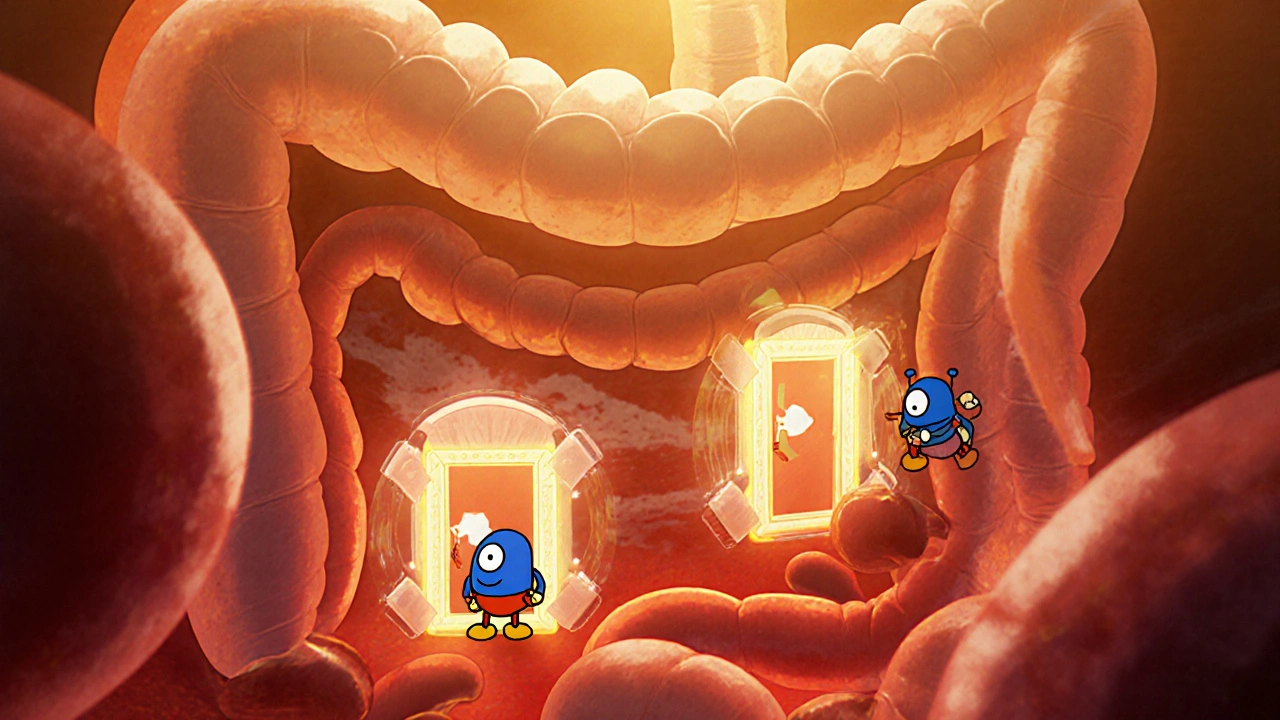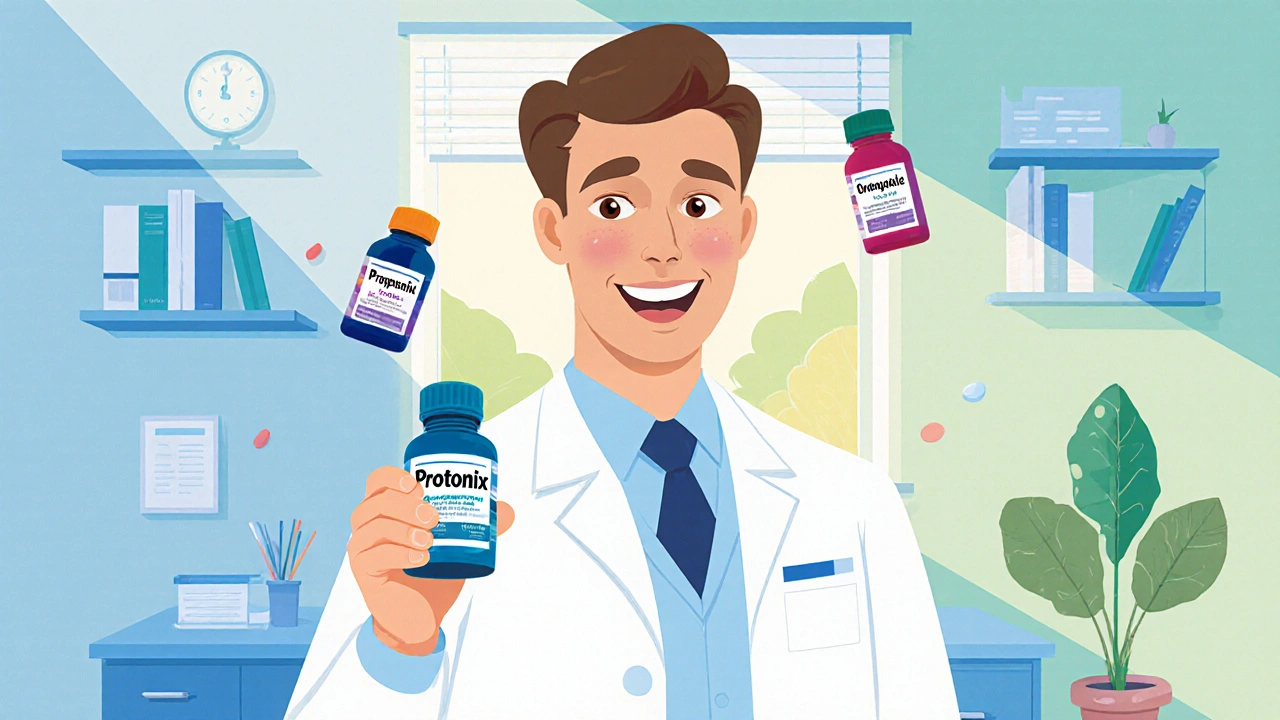When it comes to treating acid‑related conditions, Protonix (Pantoprazole) is a prescription proton pump inhibitor (PPI) that reduces stomach acid by blocking the H⁺/K⁺‑ATPase enzyme in gastric parietal cells. It’s a go‑to choice for many doctors, but you’re probably wondering how it stacks up against other options on the market. Below is a straightforward, side‑by‑side look at Protonix and the most common alternatives, so you can decide which acid‑reducer fits your needs.
Quick Takeaways
- Protonix is a potent, once‑daily PPI with a high barrier to drug interactions.
- Omeprazole and esomeprazole are the most widely used PPIs and are available over the counter in many regions.
- H2‑blockers like ranitidine and famotidine work faster but often need multiple doses per day.
- Patients with CYP2C19 poor‑metabolizer status may see higher Pantoprazole levels.
- Choosing the right drug depends on condition severity, dosing convenience, cost, and personal tolerance.
How Protonix Works
Protonix belongs to the class of proton pump inhibitors. By irreversibly binding to the gastric H⁺/K⁺‑ATPase (the “proton pump”), it shuts down the final step of acid production. The effect lasts for about 24 hours, which is why a single daily dose is usually enough for most patients.
Because the inhibition is irreversible, new pumps must be synthesized before acid production resumes. This mechanism gives PPIs a longer duration of action compared with H2‑blockers, which only compete with histamine at the H2 receptor.
When Doctors Prescribe Protonix
Typical indications include:
- Gastro‑esophageal reflux disease (GERD) with erosive esophagitis.
- Peptic ulcer disease, especially when caused by NSAIDs.
- Prevention of ulcer recurrence after healing.
- Zollinger‑Ellison syndrome (rare, but the high potency helps).
Dosage is usually 40 mg once daily, taken at least 30 minutes before the first meal. For severe erosive disease, some clinicians start with 40 mg twice daily for 4-8 weeks, then taper.
Major Alternatives to Protonix
Below are the most common acid‑reducing drugs you’ll encounter. They fall into two families: PPIs and H2‑blockers.
Other Proton Pump Inhibitors
- Omeprazole (brand: Prilosec) - older PPI, widely available OTC in 20 mg tablets.
- Esomeprazole (brand: Nexium) - the S‑enantiomer of omeprazole, marketed as having slightly better bioavailability.
- Lansoprazole (brand: Prevacid) - commonly used for maintenance therapy.
- Rabeprazole (brand: Aciphex) - fast onset, less affected by CYP2C19 genetics.
H2‑Blockers
- Ranitidine (brand: Zantac) - historically popular, but many markets withdrew it due to NDMA impurity concerns.
- Famotidine (brand: Pepcid) - safer alternative to ranitidine, works within 30‑60 minutes.

Side‑Effect Profile at a Glance
PPIs, including Protonix, share a core set of possible adverse effects. H2‑blockers tend to be milder, but they have their own quirks.
- Headache, diarrhea, nausea - common across most PPIs.
- Long‑term risk of Clostridioides difficile infection and bone fracture due to reduced calcium absorption.
- Potential for vitamin B12 deficiency with prolonged use (>1 year).
- H2‑blockers may cause constipation or rare central nervous system effects (especially in the elderly).
Drug‑Interaction Landscape
Because PPIs raise gastric pH, they can affect the absorption of drugs that need an acidic environment (e.g., ketoconazole, atazanavir). Protonix has a relatively low interaction burden compared with omeprazole, which is a stronger CYP2C19 inhibitor.
Famotidine, on the other hand, has minimal CYP involvement, making it a safer pick for patients on multiple medications.
Cost and Accessibility
In Canada, Protonix is a prescription‑only drug and typically costs between CAD 40‑70 for a 30‑day supply, depending on provincial formularies. Omeprazole and lansoprazole are available OTC for about CAD 15‑25 per month, while esomeprazole sits in the CAD 30‑45 range.
H2‑blockers are the cheapest option, with famotidine OTC costing roughly CAD 10‑15 for a month’s supply.
Comparison Table
| Drug | Brand Names | Typical Dose | Onset | Duration | Common Side Effects | Notable Interactions |
|---|---|---|---|---|---|---|
| Protonix (Pantoprazole) | Protonix | 40 mg once daily | 1‑2 hrs | ~24 hrs | Headache, diarrhea, nausea | Low CYP2C19 impact; caution with HIV protease inhibitors |
| Omeprazole | Prilosec, Losec | 20‑40 mg once daily | 1‑2 hrs | ~24 hrs | Same as above, plus possible rash | Strong CYP2C19 inhibitor - affects clopidogrel |
| Esomeprazole | Nexium | 20‑40 mg once daily | 1‑2 hrs | ~24 hrs | Diarrhea, abdominal pain | Similar to omeprazole, high CYP2C19 inhibition |
| Lansoprazole | Prevacid | 15‑30 mg once daily | 1‑2 hrs | ~24 hrs | Headache, GI upset | Moderate CYP interactions |
| Rabeprazole | Aciphex | 20 mg once daily | <1 hr | ~24 hrs | Nausea, dizziness | Least CYP2C19‑dependent |
| Famotidine | Pepcid | 20‑40 mg twice daily | 30‑60 min | 4‑6 hrs | Constipation, headache | Minimal CYP involvement |

Decision Guide: Which Acid‑Reducer Is Right for You?
Use the following flow to narrow down the best choice.
- Severity and Frequency: For chronic GERD or healed ulcers, a PPI (Protonix, omeprazole, esomeprazole) is usually preferred because of the longer acid suppression.
- On‑Demand Relief: If you only need occasional relief after meals, an H2‑blocker like famotidine works faster and can be taken as needed.
- Drug‑Interaction Concerns: Patients on clopidogrel or certain antivirals should avoid strong CYP2C19 inhibitors (omeprazole, esomeprazole) and may favor Protonix or rabeprazole.
- Cost Sensitivity: OTC omeprazole or famotidine are budget‑friendly. If insurance covers Protonix, the convenience of once‑daily dosing might outweigh the price.
- Genetic Factors: Poor CYP2C19 metabolizers can experience higher Pantoprazole levels, potentially increasing side‑effects. In those cases, rabeprazole or an H2‑blocker is safer.
Remember that long‑term PPI use should be periodically re‑evaluated by a healthcare professional to avoid unnecessary exposure.
Safety Tips & Monitoring
- Take the medication at least 30 minutes before breakfast for optimal absorption.
- If you need to switch between PPIs, keep a 24‑hour gap to prevent rebound acid hypersecretion.
- Schedule a bone‑density test if you’ve been on any PPI for more than two years and have risk factors for osteoporosis.
- Report persistent diarrhea, unexplained weight loss, or black stools to your doctor-these could signal a serious infection or ulcer complication.
Frequently Asked Questions
Can I take Protonix and an H2‑blocker together?
Generally, it’s not recommended because the PPI already provides maximum acid suppression. Adding an H2‑blocker may increase side‑effects without extra benefit, unless a doctor specifically orders it for breakthrough symptoms.
How long does it take for Protonix to start working?
Most patients notice symptom relief within 1‑2 hours, but full healing of esophageal erosions can take 4‑8 weeks of consistent dosing.
Is Protonix safe during pregnancy?
Category B in the US FDA system, meaning animal studies showed no risk but there are limited human data. Discuss with your obstetrician before starting.
What should I do if I miss a dose?
Take the missed dose as soon as you remember unless it’s near the time of your next scheduled dose. In that case, skip the missed one-don’t double up.
Are there any foods I should avoid while on Protonix?
There’s no strict restriction, but high‑fat meals can delay absorption. Staying with a balanced diet helps the medication work consistently.
Next Steps
If you’re considering switching from an over‑the‑counter PPI to Protonix, or if you’re unsure which alternative fits your lifestyle, schedule a brief consult with your pharmacist or physician. Bring a list of current meds, any known allergies, and a note of your symptom pattern. A short discussion can clarify whether a once‑daily prescription PPI, an OTC option, or an H2‑blocker is the smartest choice for you.
Armed with this comparison, you can make a confident decision about acid‑reducer therapy-whether that’s sticking with Protonix, trying an OTC PPI, or opting for a fast‑acting H2‑blocker.


Nicole Boyle
October 19, 2025
The pharmacokinetic profile of pantoprazole demonstrates a high bioavailability and a moderate half‑life, which supports its once‑daily dosing regimen. Its irreversible binding to the H⁺/K⁺‑ATPase confers a prolonged acid suppression effect that persists for about 24 hours. Compared with omeprazole, pantoprazole exhibits a lower affinity for CYP2C19, reducing the likelihood of drug‑drug interactions. Clinical guidelines often recommend it as a first‑line agent for erosive esophagitis due to its potency. However, cost considerations remain a barrier in some provinces, especially when OTC alternatives are viable options for milder cases.
Caroline Keller
October 19, 2025
Honestly this whole PPI hype feels like a corporate trap selling us unnecessary chemicals to mask symptoms instead of fixing lifestyle choices!
dennis turcios
October 19, 2025
While the enthusiasm for acid reducers is understandable, we must evaluate the risk‑benefit ratio on a case‑by‑case basis. Overprescription can lead to nutrient malabsorption, particularly vitamin B12 and magnesium. Patients with mild GERD often respond adequately to lifestyle modifications before escalating to PPIs. Moreover, the long‑term safety data for chronic pantoprazole use are still emerging, and clinicians should monitor bone density where appropriate. A blanket approach without individualized assessment does a disservice to both efficacy and safety.
Jameson The Owl
October 19, 2025
The regulatory oversight that permits PPIs like pantoprazole to dominate the market is not a coincidence but a calculated move by pharmaceutical conglomerates to maintain control over gastrointestinal therapeutics. Historically these entities have leveraged lobbying power to influence formulary decisions, ensuring that newer, costlier agents receive preferential placement over older generics. This strategy is reinforced by a network of clinical guidelines that often cite industry‑funded studies as primary evidence. Consequently, clinicians may be subtly guided toward prescribing high‑margin drugs, perpetuating a cycle of dependency on proprietary formulations. Add to this the fact that many physicians receive incentives for speaking engagements, which further blurs the line between unbiased medical advice and marketing. The result is an ecosystem where patient care decisions are intertwined with profit motives, compromising the principle of evidence‑based practice. Moreover, the suppression of adverse event reporting in certain trials raises concerns about the true safety profile of long‑term proton pump inhibition. It is essential to recognize that this is not merely a matter of pharmacology but of systemic manipulation that jeopardizes public health. Independent research, free from corporate sponsorship, is crucial to unravel the actual efficacy and risks associated with chronic PPI use. Until such data become widely available, the medical community must remain vigilant and critically assess each prescription decision. The broader implication is a call for transparency in drug approval processes and a reevaluation of the economic forces shaping therapeutic standards.
Sarah Unrath
October 20, 2025
Protonix works well but it can be pricye.
James Dean
October 20, 2025
If you think about the essence of acid suppression it reflects a deeper dialogue between body and environment the stomach’s role is not merely to digest but to signal broader metabolic states
Monika Bozkurt
October 20, 2025
While acknowledging the therapeutic benefits of pantoprazole, it is prudent to consider patient‑centred factors such as adherence potential and socioeconomic constraints. In practice, shared decision‑making can harmonize clinical efficacy with individual preferences, thereby optimizing outcomes. Moreover, the utilization of evidence‑based dosing algorithms mitigates unnecessary exposure and preserves resource allocation. I encourage clinicians to integrate these considerations into their prescribing habits for a more holistic approach.
Penny Reeves
October 20, 2025
One must appreciate that the nuanced pharmacodynamics of pantoprazole set it apart from its peers, rendering it the quintessential choice for complex ulcerative pathology.